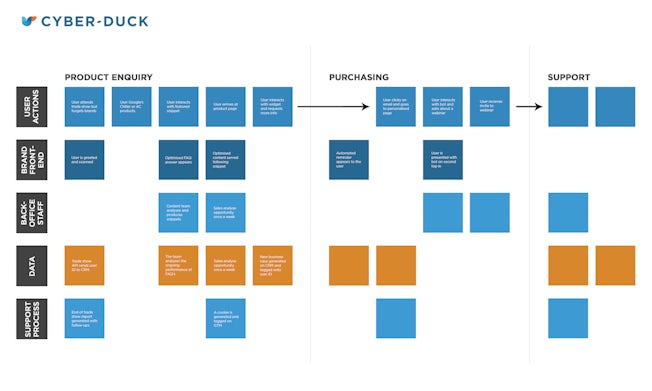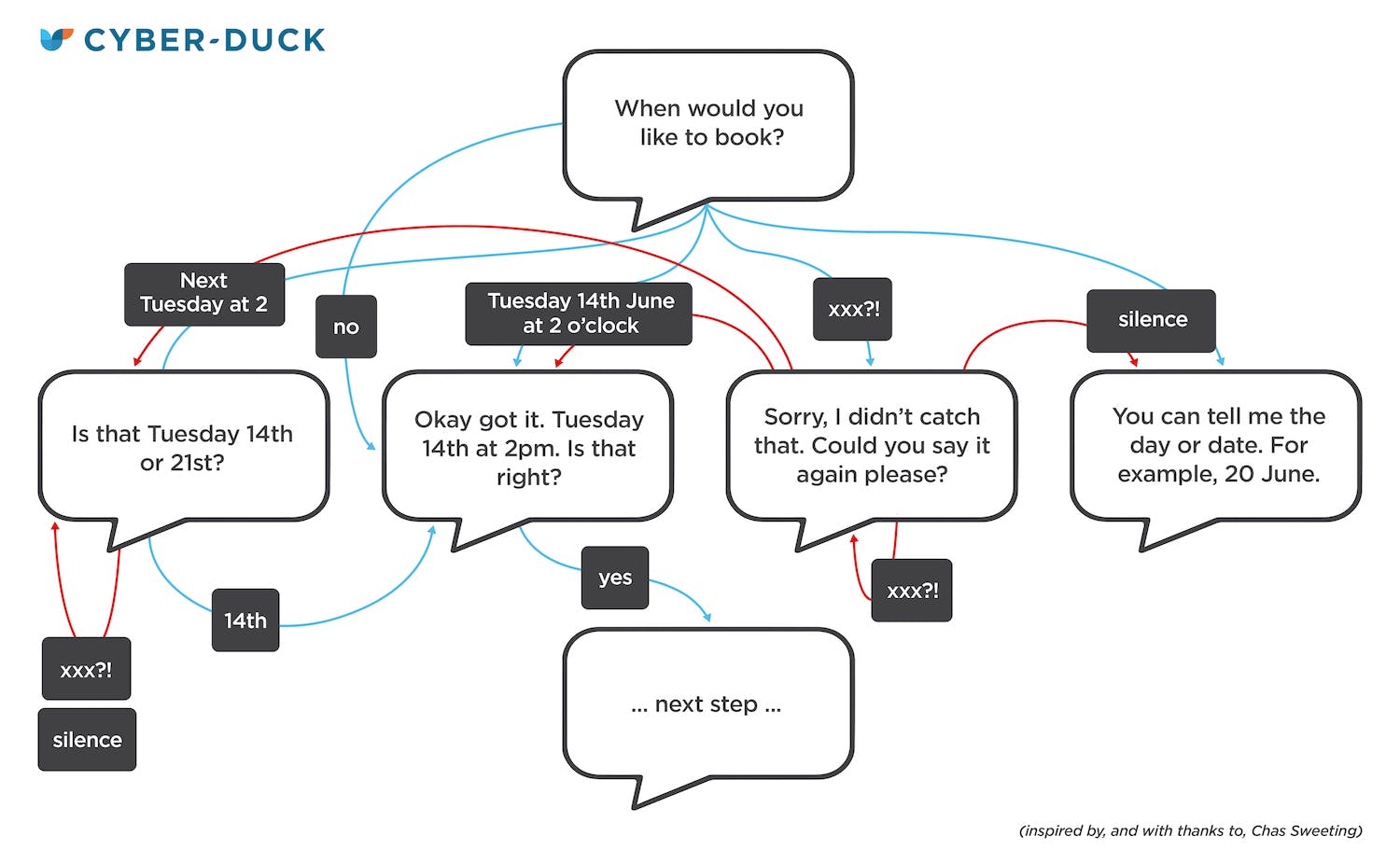Conversational user interfaces (CUI) give us the potential to communicate with machines simply and naturally.
These new kinds of interfaces should be easy for humans to adopt – and because of their ease, can make digital experiences more open, inclusive and accessible than ever before.
There are two distinct modalities of CUI: voice assistants (e.g. Google Home or Amazon Alexa), with companies able to develop and share ‘skills’ to interact with customers; and chatbots, custom-built by companies to engage with customers instantly on their own websites, for example.
Underpinned by AI, many organisations are using CUI to cope with unforeseen enquiries as well as deal with ‘standard’ automation such as sales and support.
But designing a bot that delivers value, or ‘converts’ the user is challenging. Getting a bot or voice assistant to emulate the myriad and nuanced responses that a human (or even well-designed website or app) can provide is often untenable.
To craft a truly useful bot, we need to be upfront about the fact that users are communicating via a bot and manage their expectations regarding its utility. If users anticipate that the bot or voice assistant can perform tasks or duties that it cannot, the user will hit a roadblock. According to Jakob Nielsen, the world’s leading usability expert, “user research shows that they (bots) have a hard time whenever users deviate from such flows.”
How can we help bots to perform better and design CUI that works?
That’s where user experience (UX) comes in. Through usability research and testing, UX designers have the skills to streamline natural language’s infinite possibilities into one clear conversational user interface understanding, action or response. Here’s how.
1. Product viability and UX research
You haven’t got time or budget to build a conversational user interface just because.
Examine your strategic goals and talk to your stakeholders. Then establish as much as you can about the target audience. What are their needs? What are their goals? What tasks should the bot perform? Importantly, what utility can the bot perform that suits its modality (Hint: question asking is great, but bots can also contain rich and interactive media within them).
Blend qualitative and quantitative data to get a holistic picture – website, app or system data is useful, but talking to your customer support team can provide deeper insight.
Typically, bots are great for questions about a product or service, calculating tool or support, escalation and messaging. Once you decide your bot is a viable ‘product’, you will need to ensure you research valid use cases based on user data and research.
2. Identify CUI opportunities
Quite often, before you take a step forward, you need to take a step backwards. Once you understand the tasks that the users need to complete, map customer journeys against all of your services and systems to ensure that you have enough data.
It also helps to ensure the bot you are planning to develop can support and work with your other channels. This is important, as if you design a bot that works out of sync with your website or customer support, you will fail to deliver the desired customer experience.
This is where a service design blueprint comes in. Not only does it help to map the customer experience from start to finish, but it also highlights what data, processes, APIs, systems and channels you need and how they all link to together. One of the biggest opportunities for AI lies in workflow optimisation or automation.

The service blueprint will help you understand how a CUI could fit into your organisation. It breaks down journeys into specific tasks. Which of these tasks requires a lot of manual work and processing and could be automated or augmented by AI? How complex would a CUI need to be? How much data would it need to handle and most importantly, do you have the right data or tagging to enable the CUI or AI?
Ask yourself this: are there any user or back-office workflows that either your user or your team could benefit from automation or machine intelligence? It could well be that a CUI or AI is not the answer, but worst-case scenario, you’ll be thinking about automation or creating algorithms, which is a scaled down and ‘dumber’ version of AI.
If your new programmatic wizardry learns as it goes along and does things differently to when it was first programmed, that’s generally AI. If you are automating or producing an algorithm or an automated script, it technically will not classify as AI. Conversational UI and bots generally deal with a multitude of unprogrammed situations to parse the user to the right place. The better CUI bots out there are able to learn by themselves and through additional human input, thus becoming more intelligent as a result.
3. Decide on chatbots vs. voice assistants
There are three main types of conversational user interfaces, each with different functionality. The type you choose will depend on the complexity and nature of the tasks you need your conversational user interface to complete.
Message-based interfaces (chatbots): These are the interfaces you see in messaging apps or that pop-up when you’re browsing websites or using an app.
Spoken interfaces (VUIs): These natural-language interfaces rely on voice alone and are generally at the cheaper price-point or of the older generation. Many of the voice assistant devices we have at home, like Amazon Echo and Google Home, don’t have a screen.
Combined, or voice-led, interfaces: These voice assistants also incorporate screens that display information to users. There’s a broad range, from Apple’s Siri – whose voice supplements a message-based interface, usually by reading the information out loud – and in-car systems like Mercedes’ MBUK and BMW’s ‘Hey BMW’, to Amazon’s Echo Show, where the voice and screen elements complement each other. Here, the screen might show the current weather while the voice assistant advises you to carry an umbrella, if rain’s predicted, or a jacket, if it’ll get cold later.
4. Design your conversation
Once you know your users and you’ve chosen your interface style, you’re ready to design your conversations. A UX approach is your secret weapon here. UX design centres your focus on helping customers complete their goals. UX underpins any website or app design process and is already playing a vital role in the development of conversational user interfaces.
The three major components of any conversational user interface conversation are:
- Intents – The purpose behind a user’s input
- Entities – Types of words that the bot uses to recognise an intent
- Dialogue states – How the bot shapes the flow of a conversation
Here’s an example…

Of course, just because we’re asking for the same thing doesn’t mean we’ll use the same language. As Yoda might say, “Talk the same, we do not.”
Our conversations aren’t always linear, either. The task you’ve assigned to your CUI might look simple, but to create a robust experience, it’ll need to handle a lot of complexity. It’s not easy to do this, but there are guides that can help.

Once you’ve mapped your conversation, think about how to handle errors or escalate enquiries that the CUI can’t answer. That could be asking them to repeat the question, frame it in a different way or even route the customer to a call centre. Remember to capture any errors, too – they’re valuable feedback for your developers or the team that manage the admin side of the bot as they iterate the CUI.
5. Bring your conversational user interface to life
As humans, we’re social beings and we like conversations. We respond to people who are friendly and engaging, and find artificial, cold or stilted conversations unsettling.
So, while functionality must come first, we also need to give our conversational user interface the personality to create conversations that are automated yet feel authentic.
Partly, that’s down to how we structure them. Key elements of any conversation include:
- Initial recognition (eye contact, verbal greeting)
- Taking turns to speak
- Confirmatory responses (e.g. nodding)
- Memory and context (remembering the user’s history; learning their preferences and interests from repeat or related requests)
A major consideration with CUI is tone of voice and sentiment analysis. Conversational user interfaces are getting smarter all the time, but still struggle with the nuances of human conversation and tone of voice. Sentiment analysis is one of the harder things for AI to ‘figure out’. For example, how would a CUI classify this statement: “I want to keep my mobile phone but want to upgrade.”? This statement could have a number of meanings in the real world, let alone to a CUI. Many of the leading chatbots use a natural language understanding (NLU) engine to try and figure out if something is negative or positive.
Until CUI intelligence becomes as good as humans are (which is unlikely for many years), the onus is on UX designers to not only plan for understanding intent and the ‘visual’ flow of dialogue, but also plan for situations where conversations don’t go according to plan.
Conclusion
A UX approach will give you confidence that you’re building a conversational user interface that will prove its worth to your customers.
- Research how you can support your customers to meet your business objectives
- Understand what data you need to enable new types of CUI and AI
- Map your customers’ journeys to discover the opportunities for CUIs
- Choose your type of CUI and systems depending on the customer needs
- Design your conversation and verify it with usability testing
- Add personality to help your CUIs feel natural and authentic
And if you can do that? Your users – and you – will benefit from easy, efficient, effective experiences that help them meet their goals.







